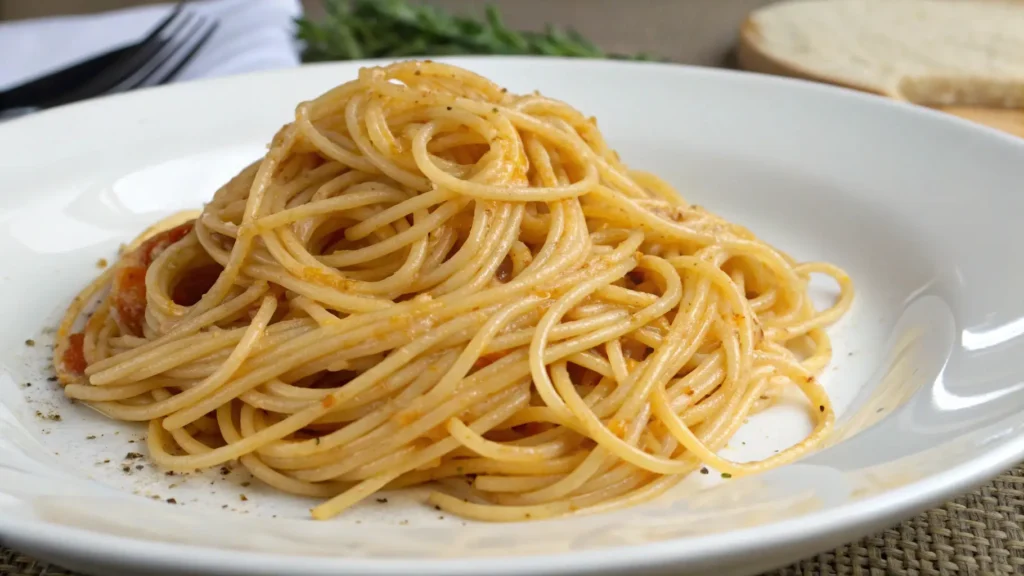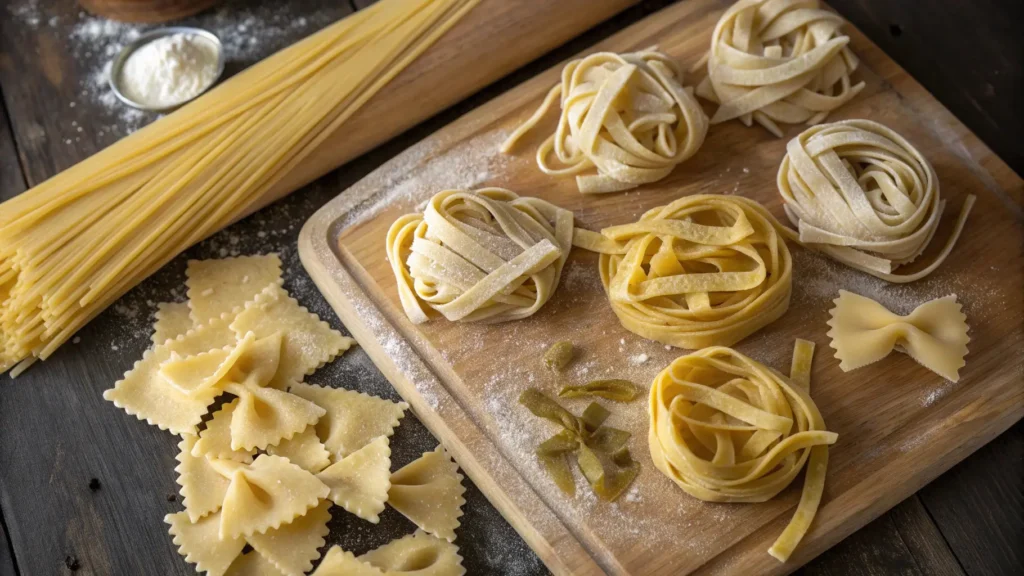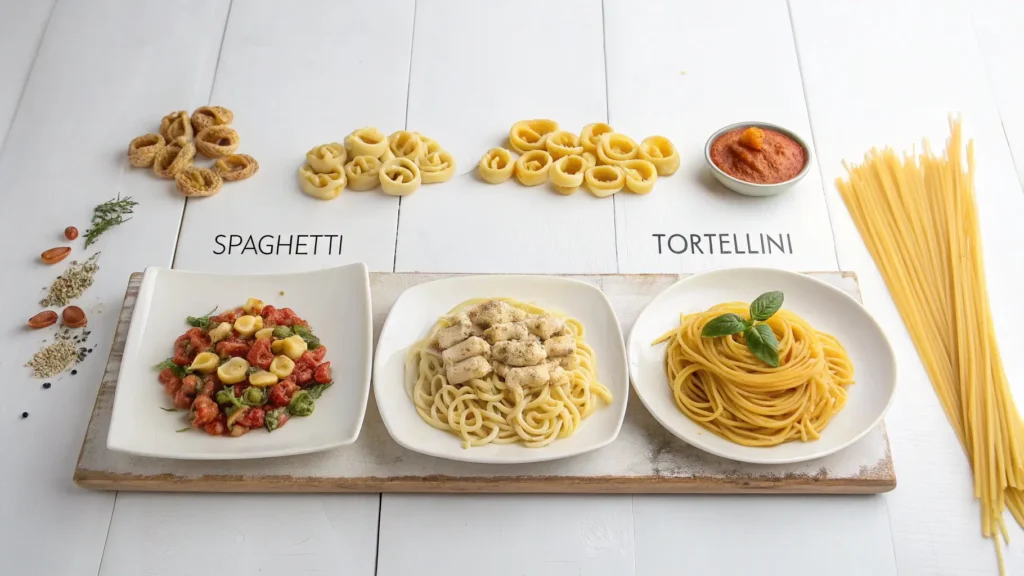Italian pasta is more than just food—it’s a cultural icon, a staple of Italy’s culinary identity, and a symbol of shared meals. With over 300 pasta shapes and countless recipes, the world of Italian pasta is as diverse as it is delicious. But among these varieties, you might wonder, “What is the most Italian type of pasta?”

In this article, we’ll dive into the history and cultural significance of pasta, explore iconic pasta types from different regions, and uncover why certain pasta varieties stand out as quintessentially Italian. By the end, you’ll have a deeper appreciation for the traditions and flavors that make Italian pasta so beloved.
Introduction to Italian Pasta
The Cultural Significance of Pasta in Italy
In Italy, pasta is more than a meal—it’s an experience. It represents tradition, family, and regional pride. From Sunday dinners to festive celebrations, pasta is at the heart of Italian culture. Each shape and recipe tells a story, reflecting local ingredients and culinary creativity.
Pasta also serves as a bridge between the past and present. Recipes passed down through generations ensure that the flavors of Italy remain alive, while innovative chefs continue to reinvent classic dishes. The result? A cuisine that’s timeless yet ever-evolving.
Origins of Italian Pasta: A Historical Overview
While pasta’s origins are often debated, it’s clear that Italy transformed it into an art form. Some believe Marco Polo brought pasta to Italy from China, while others trace its roots to Arab traders or ancient Roman dishes.
What’s undisputed is Italy’s role in popularizing pasta. By the 13th century, dried pasta became a staple in Southern Italy due to its long shelf life and versatility. Over time, regions like Emilia-Romagna, Campania, and Sicily developed their own unique pasta styles, reflecting their local flavors and ingredients.
Now that we’ve set the stage, it’s time to explore some of the most iconic pasta types that embody the essence of Italian cuisine.
Exploring the Most Italian Pasta Types
Spaghetti: The Quintessential Italian Classic
When pondering, “What is the most Italian type of pasta?”, spaghetti inevitably comes to mind. This long, thin pasta is a universal symbol of Italian cuisine, celebrated for its simplicity and versatility.
Spaghetti has its roots in Southern Italy, particularly Sicily, where durum wheat semolina is a staple. Traditionally paired with tomato-based sauces, olive oil, or fresh herbs, spaghetti’s adaptability has made it a global favorite. Iconic dishes like spaghetti al pomodoro and spaghetti carbonara showcase how a few simple ingredients can create magic on a plate.
Whether enjoyed with meatballs in the U.S. or seafood along Italy’s Amalfi Coast, spaghetti’s timeless appeal cements its status as an Italian classic.
Ravioli: A Northern Italy Specialty
Another contender for the most Italian type of pasta is ravioli. This square-shaped, stuffed pasta originated in the Lombardy region but has since become a nationwide favorite.
Ravioli’s fillings vary by region, ranging from spinach and ricotta in the north to hearty meats and cheeses in central Italy. It’s often served with butter and sage or submerged in broths, highlighting the flavors of its filling. Circular variations, called mezzelune, offer a delightful twist on the traditional shape.
The artistry behind ravioli lies in its delicate dough and the balance of flavors within. It’s a dish that embodies Italy’s knack for elevating humble ingredients into something extraordinary.
Lasagna: Iconic Layers of Tradition
No discussion of Italian pasta would be complete without mentioning lasagna. Originating in Emilia-Romagna, this layered pasta dish has become synonymous with comfort food.
Made with sheets of pasta, rich ragù, béchamel sauce, and a generous sprinkle of Parmesan, lasagna is a true labor of love. Its origins date back to ancient Rome, but it’s in Bologna where lasagna reached culinary perfection. Today, it’s a staple at Italian gatherings and family dinners worldwide.
Lasagna’s hearty, satisfying nature makes it a strong contender for the most Italian type of pasta, embodying the heart and soul of Italian cooking.
Regional Variations of Italian Pasta
Penne and Macaroni from Campania
Campania, home to Naples and the Amalfi Coast, is known for its robust pasta dishes. Penne, with its cylindrical shape and diagonal cut, is a regional favorite. It’s often paired with tomato-based sauces, like arrabbiata, which highlights the region’s love for bold flavors.
Macaroni, another Campanian classic, has a slightly curved shape that makes it perfect for baked dishes and hearty casseroles. Made from durum wheat semolina, both penne and macaroni capture the essence of Italian comfort food.
Gnocchi from Veneto: A Dumpling Twist
Venturing north to Veneto, gnocchi offers a unique take on pasta. These soft dumplings, made from potatoes, flour, and eggs, are a culinary delight. While not a traditional noodle, gnocchi is often grouped with pasta due to its role in Italian cuisine.
Gnocchi pairs beautifully with creamy sauces, sage butter, or pesto, showcasing Veneto’s preference for subtle yet flavorful dishes. Its origins trace back to Roman times, but its popularity endures, making it a must-try on any Italian menu.
Linguine from Liguria: A Coastal Favorite
In the coastal region of Liguria, linguine reigns supreme. Its long, flat shape is ideal for seafood dishes, particularly linguine alle vongole (linguine with clams).
Liguria is also the birthplace of pesto, and linguine’s smooth texture makes it the perfect vessel for this iconic basil-based sauce. The combination of pasta, pine nuts, garlic, and Parmesan creates a harmonious blend that captures the essence of Ligurian cuisine.
How Pasta Shapes Reflect Italian Culinary Identity

Matching Pasta Shapes with Regional Sauces
Italy’s rich culinary traditions emphasize pairing the right pasta shape with the perfect sauce. For example, long, thin pastas like linguine work best with lighter, oil-based or seafood sauces, such as linguine alle vongole. Conversely, sturdy shapes like penne or rigatoni excel at capturing hearty ragù or creamy sauces in their ridges.
This thoughtful pairing isn’t just about texture—it’s about ensuring every bite delivers a balanced, flavorful experience. When asking, “What is the most Italian type of pasta?”, considering its pairing with regional sauces provides deeper insight into its culinary significance.
How Shape Influences Texture and Taste
The shape of pasta affects its cooking time, how it holds sauce, and even its overall taste. For instance, delicate shapes like ravioli are designed to showcase their fillings, while robust options like lasagna can support layered, baked dishes. The iconic twist of fusilli or the small, tube-like design of ziti ensures that sauces cling evenly, enhancing every bite.
This interplay of shape and flavor is a testament to the ingenuity of Italian cuisine, where even the smallest details are considered to create a perfect dish.
The Evolution of Italian Pasta Over Time

Ancient Roots of Italian Pasta
The history of pasta in Italy is steeped in tradition and innovation. While many associate its origins with Marco Polo’s travels to China, historical evidence suggests pasta existed in Italy long before his return. Arab traders introduced dried pasta to Sicily, where the warm climate made it ideal for storage and transportation.
From its early days as a practical, non-perishable food, pasta evolved into a symbol of Italian culture. Over the centuries, regions adapted pasta to their local ingredients, creating unique shapes and recipes that reflect their culinary identity.
Modern Takes on Traditional Favorites
Today, Italian pasta continues to evolve, balancing tradition with modern trends. Artisanal pasta makers preserve centuries-old techniques, while contemporary chefs experiment with new flavors and shapes.
For instance, gluten-free and whole-grain pastas cater to modern dietary preferences without compromising on taste or texture. Meanwhile, innovative dishes like truffle-infused tagliatelle or squid ink spaghetti offer fresh interpretations of classic recipes. Even with these innovations, the essence of Italian pasta remains rooted in simplicity and quality.
Why Pasta is a Timeless Icon of Italian Cuisine
Cultural Significance of Pasta in Italy
Pasta is more than a meal—it’s a way of life in Italy. It’s the centerpiece of family gatherings, Sunday lunches, and celebratory feasts. Each dish tells a story, connecting people to their heritage and to each other.
As you explore what is the most Italian type of pasta, it becomes clear that pasta isn’t just about taste. It embodies the values of Italian cuisine: fresh ingredients, balance, and respect for tradition. Whether it’s a simple plate of spaghetti aglio e olio or an elaborate lasagna alla Bolognese, pasta reflects the heart of Italian culture.
Global Love for Italian Pasta
Italian pasta has transcended borders, becoming a beloved food worldwide. Its versatility, affordability, and ability to bring people together make it a universal favorite. While regional dishes like cacio e pepe and pesto alla Genovese remain true to their Italian roots, they’ve inspired countless adaptations in kitchens around the globe.
As a timeless icon, pasta represents more than Italy’s culinary history—it symbolizes its passion for food, family, and togetherness. With every bite, you’re tasting a piece of Italy’s soul.
FAQs About Italian Pasta
What is the Most Italian Type of Pasta?
It’s tough to pick just one, but classics like spaghetti, ravioli, and lasagna consistently stand out. Each represents a unique aspect of Italy’s culinary heritage, from the simplicity of tomato-based sauces to the richness of stuffed or layered pasta dishes.
How Many Types of Pasta Exist in Italy?
Italy is home to over 300 pasta shapes, each with regional variations and specific recipes. These range from well-known favorites like penne and gnocchi to lesser-known varieties like strozzapreti and orecchiette.
Why is Pasta So Popular in Italy?
Pasta’s popularity lies in its versatility and deep cultural roots. It’s affordable, easy to prepare, and pairs beautifully with local ingredients, making it a staple in households and restaurants alike.
For more pasta inspiration, check out The Ultimate Guide to Gigli Pasta for an in-depth look at another fascinating Italian variety.

